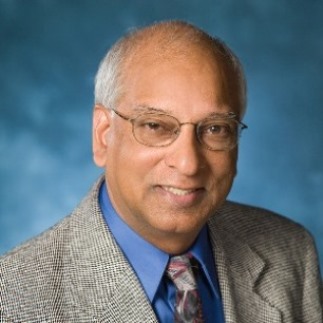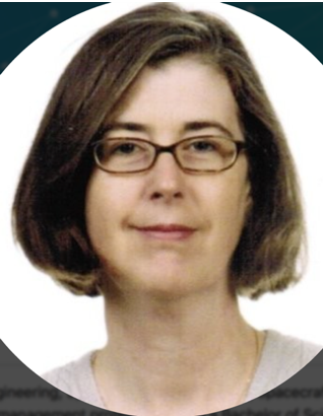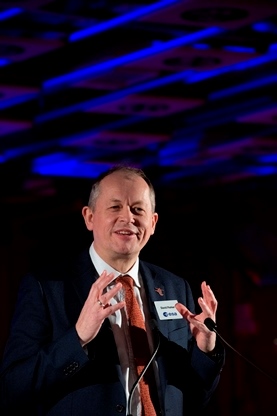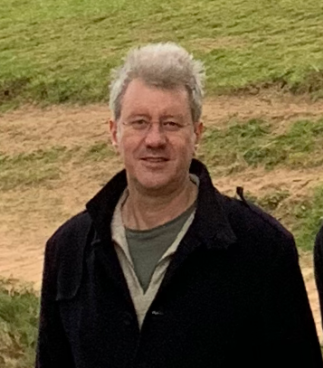| Monday 8 July 2019 |  | Professor Sushil Atreya, University of Michigan, "in situ, forever" Sushil Atreya is a planetary scientist and a professor of climate and space sciences and engineering at the University of Michigan. His research spans crosscutting themes of planetary formation, atmospheric origin and evolution, and astrobiology. He has worked on several solar system exploration missions including Juno, MSL-Curiosity Rover, Cassini-Huygens, Galileo orbiter and probe, Voyager, Venus Express and Mars Express. | |
| Monday 8 July 2019 |  | Dr Luigi Colangeli, European Space Agency Program Discussion Present position: Head of the Science Coordination Office - Directorate of Science - European Space Agency. Education: Graduated in Physics with full marks and honours at Univ. of Lecce (Italy), 1982. PhD in Physics (area: Astrophysics) at Univ. of Bari (Italy), 1986. Career: 1987-1988: Research Fellow in the Space Science Department at ESA-ESTEC (Noordwijk, NL). 1988-1993: Researcher in Physics at Engineering Faculty, University of Cassino (Cassino, I). 1993-2001: Associate Professor at Osservatorio Astronomico di Capodimonte (Napoli, I). Since 2001: Full Professor at INAF – Osservatorio Astronomico di Capodimonte, Napoli. Nov. 2005 – March 2010: Director INAF - Osservatorio Astronomico di Capodimonte, Napoli. April 2010 – Sept. 2013: Head, Solar System Missions Division - Directorate of Science and Robotic Exploration - ESA. Oct. 2013 - Oct. 2016 Head of the Coordination Office for the Scientific Programme - Directorate of Science and Robotic Exploration - ESA. Main research areas: Study, design and realisation of instruments for space missions dedicated to the exploration of the solar system. Laboratory simulations and analyses of cosmic dust and planetary materials. Principal Investigator of the GIADA experiment - ESA "Rosetta" mission (2001-2010), now CoI. Co-Principal Investigator of the SIMBIO-SYS experiment - ESA "BepiColombo" mission (2004-2010) – now CoI. Team Coordinator of the MEDUSA experiment - ESA "ExoMars" mission (2002-2009). Co-Investigator of the VIRTIS experiment - ESA "Rosetta” mission (since 1999). Publications: More than 350 papers, of which more than 180 on main refereed astrophysical journals; some chapters of books; editor of books, volumes and special issues of journals. | |
| Monday 8 July 2019 |  | Professor Chi Wang, China's Deep-Space Exploration and Planetary Research in the Past, Current and in the Near Future Prof. Chi Wang, Director General of the National Space Science Center, Chinese Academy of Sciences. He graduated from the University of Science and Technology of China and got his PhD degree from the Massachusetts Institute of Technology, USA. He worked on the plasma experiments on Voyager 2. Starting from 2001, he led the effort to establish the first state key laboratory of space weather in China, and investigate the interaction of the solar wind with the magnetosphere. He has published more than 200 peer-reviewed papers including Nature, JGR etc. He was the PI of the Chinese Meridian Project, the ground-based space environment monitoring network in China. He is currently the mission Co-PI of the solar wind – magnetosphere – ionosphere link explorer (SMILE),an new ESA-China joint space science mission to image the magnetosphere. He is in charge of the scientific payload for Chinese Lunar and Deep Space Exploration Program including CE-4, CE-5 and the first Chinese Mars Mission, and is also the deputy chief engineer of the Chinese Lunar Exploration CE-4 mission. | |
| Monday 8 July 2019 |  | Dr Carolyn R. Mercer, Updates on NASA’s Planetary Science Programs Dr Carolyn Mercer is the founding director of NASA’s Planetary Exploration Science Technology Office (PESTO) and she runs this office for NASA’s Planetary Science Division from the NASA Glenn Research Center. PESTO is tasked with developing an investment strategy for technologies needed for future planetary science missions, managing the development of scientific instruments and systems needed for operation in extreme planetary environments, coordinating with other relevant technology developers, and infusing technologies into planetary science missions. Dr. Mercer served as the technology lead for the Solar System Small Bodies Assessment Group, and has managed the development of many space technologies, including high power solar arrays, regenerative fuel cells, advanced lithium ion batteries, and adaptive engine technologies. Dr Mercer is also the Program Executive for the Small Innovative Missions for Planetary Exploration (SIMPLEx) program. SIMPLEx solicits planetary science missions that can be accomplished using small spacecraft launched as secondary payloads. Dr Mercer has a Bachelor’s degree in Aerospace Engineering from the Ohio State University, a Master’s degree in Physics from Cleveland State University, and a Doctoral degree in Optical Science from the University of Arizona. She holds patents in phase-stepping interferometry systems for metrology, edited a book on optical diagnostics for fluids, solids, and combustion, and has authored dozens of technical papers. | |
| Monday 8 July 2019 |  | Frederic Teston, ESA plans for Planetary Defense and Small Satellites Frederic Teston is Head of the Systems Engineering Department in the Directorate of Technology, Engineering and Quality of the European Space Agency. The Systems Engineering Department is in charge of R&D activities in software, control and system engineering and of small missions and cubesat for In Orbit Demonstration. The Department currently manages the HERA mission definition phase for the S2P program. Frederic Teston has started his career in the 80's in attitude control systems for ERS and Spot4 at Airbus before joining ESA to work on avionics in the technical directorate. He was in particular the avionics engineer for the SOHO project. He has initiated small missions at ESA in early 2000 with the Proba-1 mission. Frederic Teston is graduated from Centralesupelec grande ecole in France and holds a masters in economy. | |
| Tuesday 9 July 2019 |  | David Parker, ESA Talk including discussion on ESA's contribution to Mars Sample Return David Parker became the European Space Agency’s space exploration Director in April 2016. He led the creation of the new European Exploration Envelope Programme, approved by Ministers at the Luzern Conference in December 2016. Programme highlights include regular astronaut missions to the International Space Station; the first dedicated life search of the Red Planet (ExoMars); and the first investigation of water ice on the Moon. From 2013 to 2016, Dr Parker was Chief Executive of the UK Space Agency. His initiatives included negotiating major investment in both commercial and exploration missions of ESA and the creation of the Harwell space cluster which now hosts over 50 organisations including the European Centre for Space Applications and Telecommunications (ECSAT). Other successes under his leadership included the UK’s International Partnership Programme which applies satellite applications to global development issues; the UK government’s investment in the pioneering ‘SABRE’ air-breathing rocket engine; and the education projects for Tim Peake’s ISS mission which engaged over one million school students. In total, he worked with four space ministers and has attended five ESA Ministerial Council meetings. David Parker previously worked for over a decade in the UK space industry, initially in spacecraft engineering and studies of new projects; department management; and latterly as a business development manager winning projects for UK industry including LISA Pathfinder, Aeolus and the ExoMars rover. Dr Parker has a degree in Aeronautics and Astronautics and a PhD awarded for research with NASA Langley Research Center. | |
| Thursday 11 July 2019 |  | David Pecover, ExoMars 2020 - Rosalind Franklin Rover Integration and Test Status David Pecover has been leading the Rover Vehicle design team at Airbus in Stevenage with the role of ExoMars Systems Engineering Manager since the Rover Preliminary Design Review in late 2013. David graduated in 1980 with a degree in Physics with Astrophysics from the University of Leicester, UK and was initially employed by an Airbus predecessor company working in attitude control studies and ExoSat inflight support. He joined the European Spacecraft Operations Centre (ESOC) in 1986 working on ERS-1 and then the European Space Technology Centre (ESTEC) in 1992 working in a systems engineering role on PPF/Envisat and then on Metop. David joined what is now Airbus in Stevenage in 2004 and, prior to his ExoMars role, had leading functional engineering and verification roles on the Aeolus and Solar Orbiter spacecraft. | |
| Friday 12 July 2019 |  | Tom Hoffman, Insight Overview, Jet Propulsion Laboratory, California Institute of Technology Tom Hoffman is the Project Manager of the NASA InSight mission which successfully landed on Mars in November 2018. This talk will describe these systems, detail some of the unique challenges of the InSight mission, and provide information on some of the early operational results. The InSight mission to Mars was selected as part of the NASA Discovery portfolio in 2011 and is managed by the Jet Propulsion Laboratory. InSight was launched as the first interplanetary mission from Vandenberg Air Force Base in California on May 5, 2018 and landed successfully on Mars on November 26, 2018. The mission utilized a heritage spacecraft and Lander from Lockheed Martin which had successfully landed on Mars before as the Phoenix mission. Significant changes were made to the Lander structure, power system and Entry, Descent and Landing system to adjust to the different mission parameters. Importantly, InSight is the first solar-powered stationary lander designed to last a full Mars year. The main science instruments were contributed by CNES and DLR and were designed to provide the first glimpse into the Martian interior using seismometry, heat flux and geodesy. The seismometer (SEIS) is environmentally ruggedized for Mars but has the sensitivity comparable to that of the best terrestrial seismometers. The development of the SEIS was a multi-national effort led by CNES with significant contributions from JPL and other European partners. The heat flux instrument, the Heat-flow and Physical Properties Package (HP3), was developed largely by DLR with support from JPL. This instrument is designed to penetrate up to 5 meters into the Mars regolith to determine the heat flux of Mars for the first time. A particular challenge to InSight was the development of the first system to robotically deploy these instruments from a Lander to the surface of another planet. Early results include the first seismic events and first recorded sounds from Mars. Prior to his role on InSight, Tom was the Deputy Project Manager for the GRAIL mission, a NASA Discovery mission which gravity mapped the moon. Over the past 30+ years at the Jet Propulsion Laboratory, Tom has worked on several other NASA flight projects including Voyager Operations, the Cassini mission to Saturn, Stardust which returned the first comet samples to the Earth, Spirit/Opportunity Mars rovers and several Earth science missions, as well as several technology development efforts. Tom has a BSEE in Electrical Engineering and Computer Science from University of California – Berkeley and an MSEE in Computer Engineering from the University of Southern California. | |
| Friday 12 July 2019 |  | Tom Pike, Silicon Seismometers, from Mars to Europa and Beyond, Imperial College, London Tom Pike is Professor in Microengineering at Imperial College London. After an MA and PhD in Physics at Cambridge, he spent 10 years at JPL, before returning to the UK. As well as planetary instrumentation and geophysics, he has interests in gravity sensing on Earth and the fundamental quantum limits to instrumentation. |
IPPW 2019
International Planetary Probe Workshop 2019, Oxford, UK
